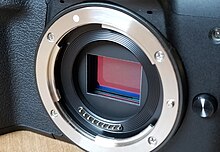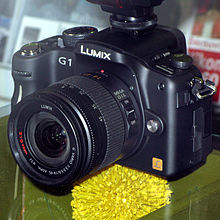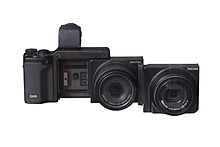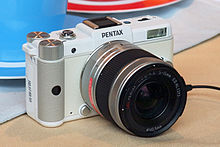|
Mirrorless camera
  A mirrorless camera (sometimes referred to as a mirrorless interchangeable-lens camera (MILC)[1] or digital single-lens mirrorless (DSLM)) is a digital camera which, in contrast to DSLRs,[2] does not use a mirror in order to ensure that the image presented to the photographer through the viewfinder is identical to that taken by the camera. They have come to replace DSLRs, which have historically dominated interchangeable lens cameras.[3] Other terms include electronic viewfinder interchangeable lens (EVIL)[1][4] and compact system camera (CSC).[1][5] Lacking a mirror system allows the camera to be smaller, quieter, and lighter.[6] In cameras with mirrors, light from the lens is directed to either the image sensor or the viewfinder. This is done using a mechanical movable mirror which sits behind the lens.[7] By contrast, in a mirrorless camera, the lens always shines light onto the image sensor, and what the camera sees is displayed on a screen for the photographer. Some mirrorless cameras also simulate a traditional viewfinder using a small screen, known as an electronic viewfinder (EVF).[6] DSLRs can act like mirrorless cameras if they have a "live view" mode, in which the mirror moves out of the way so the lens can always shine onto the image sensor.[8] Many mirrorless cameras retain a mechanical shutter. Like a DSLR, a mirrorless camera accepts interchangeable lenses. Mirrorless cameras necessarily have shorter battery life because they need to power the screen and sensor at all times.[6] DesignMirrorless cameras are mechanically simpler than DSLR cameras, and are smaller, lighter, and quieter due to the elimination of the moving mirror. While nearly all mirrorless cameras have a mechanical shutter, many also have an electronic shutter, allowing completely silent operation.[9] As the image from the lens is always projected onto the image sensor, features can be available which are only possible in DSLRs when the mirror is locked up into "live view" mode. This includes the ability to show a focus-peaking[10] display, zebra patterning, and face or eye tracking.[11] The electronic viewfinder can provide live previews of depth of field, exposure, white balance and picture style settings, as well as offer a real time view of camera settings even in extremely low or bright light levels, making it easier to view the results.[12] With the latest phase-detect autofocus available on some mirrorless cameras, the autofocus speed and accuracy of some models has been shown to be as good as DSLRs. But mirrorless cameras have shorter battery life than DSLRs due to prolonged use of LCD and/or OLED viewfinder displays, and often smaller buffers (to save battery).[13] On-sensor autofocus is free of the adjustment requirements of the indirect focusing system of the DSLR (which relies on a separate autofocus sensor located below the reflex mirror), and as of 2018 mirrorless cameras could shoot with phase-detect autofocus at up to 20 frames per second using up to 693 focus points—a number far exceeding what was available on any DSLR.[14] However, on-sensor phase detection autofocus (except for Canon's Dual Pixel Autofocus) repurposes pixel sites for autofocus acquisition, so that image data is partially or entirely missing for the autofocus "pixels", which can cause banding artifacts in the final image.[15] HistoryEarly 2000s: Digital rangefinder originsThe first digital rangefinder camera commercially marketed was the Epson R-D1 (released in 2004), followed by the Leica M8 in 2006.[16] They were some of the first digital lens-interchangeable cameras without a reflex mirror, but they are not considered mirrorless cameras because they did not use an electronic viewfinder for live preview, but, rather, an optical viewfinder.[16] Compact cameras with large sensors, technically akin to the current mirrorless cameras, were also marketed in this period. Cameras like Sony Cyber-shot DSC-R1 and Sigma DP1 proved that live preview operation is possible, and useful with APS-C sized sensors.  Late 2000s: Micro Four Thirds systemThe first mirrorless camera commercially marketed was the Panasonic Lumix DMC-G1, released in Japan in October 2008.[17] It was also the first camera of Micro Four Thirds system, developed exclusively for the mirrorless ILC system. The term mirrorless came into use in order to describe Micro Four Thirds cameras when they were announced in 2008, especially as the first Micro Four Thirds camera, the Lumix G1, was designed to be as similar to a DSLR as possible.[18] There are other terms that were created, too, but mirrorless became the most popular.[19]  The Ricoh GXR (November 2009) had a radically different design. The mirrorless camera featured interchangeable lens units – a sealed unit of a lens and sensor, instead of the lens only being interchangeable.[20][21][22] This design was different from other mirrorless cameras, and received mixed reviews, primarily due to its higher cost.[20] 2010s: Pocket mirrorless camerasFollowing the introduction of the Micro Four Thirds system, several other cameras were released by Panasonic and Olympus, with the Olympus PEN E-P1 (announced June 2009) being the first mirrorless camera in a compact size (pocketable with a small lens). The Samsung NX10 (announced January 2010) was the first camera in this class not using the Micro Four Thirds system, instead utilizing a new, proprietary lens mount (Samsung NX-mount). The Sony Alpha NEX-3 and NEX-5 (announced May 14, 2010, and released in July 2010) saw Sony enter the market with a new, proprietary lens mount (the Sony E-mount), though the camera included LA-EA1 and LA-EA2 adapters for the legacy Minolta A-mount.  In June 2011, Pentax announced the 'Q' mirrorless interchangeable lens camera and the 'Q-mount' lens system. The original Q series featured a smaller 1/2.3 inch 12.4 megapixel CMOS sensor.[23] The Q7, introduced in 2013, has a slightly larger 1/1.7 inch CMOS sensor with the same megapixel count.[24] In September 2011, Nikon announced their Nikon 1 system which consists of the Nikon 1 J1 and Nikon 1 V1 cameras and lenses. The V1 features an electronic viewfinder.[25] The series includes high-speed mirrorless cameras which, according to Nikon, had the fastest autofocus and the fastest continuous shooting speed (60 fps) of any camera with interchangeable lenses, including DSLRs.[26] The Fujifilm X-Pro1, announced in January 2012, was the first non-rangefinder mirrorless with a built-in optical viewfinder. Its hybrid viewfinder overlaid electronic information, including shifting frame-lines, to compensate for the parallax effect. Its 2016 successor, the X-Pro2, had an updated version of this viewfinder.  Beyond just consumer interest, mirrorless lens systems created significant interest from camera manufacturers as a possible alternative to high-end camera manufacturing. Mirrorless cameras have fewer moving parts than DSLRs, and are more electronic, which is an advantage to electronic manufacturers (such as Panasonic, and Samsung), while reducing the advantage that dedicated camera manufacturers have in precision mechanical engineering. Sony's entry level full frame mirrorless α7 II camera has a 24-megapixel 5-axis stabilised sensor, but is more compact and less expensive than any full-frame sensor DSLR. Canon was the last of the major manufacturer of DSLRs to announce their own mirrorless camera, announcing the Canon EOS M in 2012 with an APS-C sensor and 18 mm registration distance similar to the one used by NEX. In the longer term Olympus decided that mirrorless may replace DSLRs entirely in some categories; Olympus America's DSLR product manager speculated that by 2012, Olympus DSLRs (the Olympus E system) might become mirrorless, though still using the Four Thirds System (not Micro Four Thirds).[27] Panasonic UK's Lumix G product manager John Mitchell, speaking to the Press at the 2011 "Focus on Imaging" show in Birmingham, reported that Panasonic "G" camera market share was almost doubling each year, and that the UK Panasonic "G" captured over 11% of all interchangeable camera sales in the UK in 2010, and that the UK "CSC" sales made up 23% of the interchangeable lens market in the UK, and 40% in Japan.[28] Sony announced their 2011 sales statistics in September 2012, which showed that mirrorless lenses had 50% of the interchangeable lens market in Japan, 18% in Europe, and 23% worldwide. Since then, Nikon and others entered the mirrorless market. Due to the downward trend of the world camera market, mirrorless camera sales suffered, but not as drastically and was compensated with increase by about 12 percent in the Japanese mirrorless camera market.[29] However, mirrorless cameras took longer to catch on in Europe and North America. According to Japanese photo industry sources, mirrorless made up only 11.2% of interchangeable-lens cameras shipped to Europe in the first nine months of 2013, and 10.5% of those shipped to the U.S. in the same period.[30] An industry researcher found that mirrorless camera sales in the U.S. fell by about 20% in the three weeks leading up to December 14, 2013—which included the key Black Friday shopping week; in the same period, DSLR sales went up 1%.[30] In 2013, mirrorless system cameras constituted about five percent of total camera shipments.[31] In 2015, they accounted for 26 percent of system camera sales outside of the Americas, and 16 percent within the United States.[32] As of 2023, mirrorless cameras have come to overtake DSLRs as the dominant kind of interchangeable lens camera, with them gaining market share over DSLRs, and nearly all camera manufactures have switched entirely and exclusively to making mirrorless cameras and lenses.[33][3] Until the mid 2010s, mirrorless cameras were dismissed by many photographers, because of their laggy and low resolution screens, when compared with the clarity and responsiveness of the optical viewfinders used on DSLRs, especially under strong sunlight or when photographing the sky at night.[34][35] In addition, mirrorless cameras were known for having worse autofocus performance compared to DSLRs, and much worse battery life.[36] This negative perception of mirrorless cameras began to change around 2013, when the Sony α7 was released. It was the first professional, full-frame mirrorless camera, and, although not the first with depth aware autofocus, included small additional sensors on the main sensor to detect depth in the scene, for fast autofocus ("phase-detect").[37][38] 2015 sales statistics showed that overall camera sales have fallen to one third of those of 2010, due to compact cameras being substituted by camera-capable mobile phones. Within camera sales, mirrorless ILCs have seen their market share increasing, with ILCs being 30% of overall camera sales, of which DSLRs were 77% and mirrorless cameras were 23%.[39] In the Americas in 2015, DSLR annual sales fell by 16% per annum, while mirrorless sales over the same 12-month period have increased by 17%.[40] In Japan, mirrorless cameras outsold DSLRs during some parts of the year. In 2015, mirrorless-cameras accounted for 26 percent of interchangeable-lens camera sales outside the Americas, although a lesser share of 26 percent was in the U.S.[41] In late 2016, Olympus announced their OM-D E-M1 Mark II camera, a successor to the earlier and successful Mark I. The Mark II model retains a Micro Four Thirds image sensor of 17.3x13 mm and features a 20.4 megapixel resolution sensor, representing a new generation of mirrorless cameras competitive with and in many respects superior to DSLR cameras. Late 2010s: Full-frame mirrorless successIn early 2017, Sony announced the Alpha 9 mirrorless camera, offering 693 autofocus points, and 20 frame-per-second shooting. In October Sony announces the A7RIII, offering 10 FPS shooting at 42 megapixels. In early 2018, Sony announced the a7 III mirrorless camera, bringing the 693 autofocus points of the A9 at a much lower cost. In August, Nikon announced its new full-frame mirrorless Z6 and Z7 cameras, both using a new lens mount. Canon announced its first full-frame mirrorless model, the EOS R, and its own new lens mount the next month. At the NAB Show in April 2018, Blackmagic Design announced and demonstrated the Pocket Cinema Camera 4K at a price of $1,295 USD.[42] In early 2019, Canon officially announced their second full-frame mirrorless camera following the EOS R introduced in 2018. That said camera is the EOS RP as it was made to be entry-level for a full-frame mirrorless. [43] In July 2019, Sony announced the a7R IV with a groundbreaking 61-megapixel full-frame sensor, making it the highest-resolution full-frame camera at the time. Other improvements included 15 stops of dynamic range and 576-point phase-detection autofocus for exceptional detail and precision.[44] In October 2019, Panasonic's Lumix S1H became the first hybrid full-frame mirrorless camera certified by Netflix for use in its Original productions. This became a giant milestone in the camera industry by showing that it is possible to have a camera that is highly compact and relatively affordable (compared to traditional cinema cameras) while still meeting the high standards of a professional camera for film making.[45] 2020s: End of DSLRsIn July 2020, Canon announced both the EOS R5 and R6 to bring more mirrorless cameras to their line up. The EOS R5 was significant at the time as it was the first camera to be capable of 8K RAW video recording at up to 30 fps, positioning it as a leader in hybrid photo-video equipment.[46] The EOS R6 was viewed as the affordable sibling, offering 20 MP stills, 4K 60 fps video, and 8 stops of image stabilization, appealing to enthusiasts and professionals alike.[47] Also in July 2020, Sony announced the a7S III, which was a much-anticipated camera as it was aimed at professionals, especially videographers, as it retained a focus on low-light performance and video features.[48] Throughout 2020 there had been major improvements with achieving the ability to shoot in low light[48] to being able to record in 8K RAW,[47] 2020 was one of the most impactful years as it introduced new things to both photography and videography. The year 2021 marked a turning point for mirrorless cameras, as they surpassed DSLRs in shipments, accounting for over 67% of total camera sales.[49] On January 26, 2021, Sony announced the Alpha 1 and it had set the benchmark as it competed with the Canon EOS R5, being able to shoot video in 8K at 30 fps and 4K at 120 fps modes, as well as showcasing a 9.44-million-dot OLED EVF with a 240 Hz refresh rate.[50] The Alpha 1 aimed to unify both photography and videography at a professional level. A day later, Fujifilm released the GFX 100s, featuring a smaller and lighter body holding a 102 MP medium-format sensor. This camera is compared to the original GFX 100 with 6 stops of in-body image stablization (IBIS) and 4K video recording at 30 fps.[51] Nikon, towards the end of the year in October, released the Z9, its flagship full frame mirrorless model. It featured Nikon's best autofocus performance with 3D tracking, 8K video, 60 fps RAW shooting as well as offered cutting-edge speed and reliability with its stacked CMOS sensor.[52] For the year 2021, Sony led the market with a 32% share, followed closely by Canon at 28.2%, reflecting the growing preference for compact, versatile, and professional-grade systems. These cameras catered to both photographers and filmmakers, pushing the boundaries of image quality, autofocus, and video capabilities.[53] Some expansions to the mirrorless camera is that hybrid cameras had gained a dominance as cameras like the Canon EOS R5 C and Fujifilm X-H2S are catered to professionals going for high-resolution photo performance alongside 8K recording and internal ProRes capabilities.[54] Some more improvements are how the APS-C format had become a focus of innovation—cameras like the Canon EOS R7 or the R10, alongside Fujifilm's X-H2 and X-H2S, highlighted how APS-C cameras could offer professional-grade specs like high burst rates and advanced autofocus, all while remaining compact and more affordable than full-frame systems.[55] These systems have leaned more on an emphasis on content creators such as vloggers and YouTubers. In 2022, mirrorless systems continued to dominate the digital camera market, accounting for 69% of interchangeable lens camera shipments—a 31% increase from the previous year, as reported by Camera & Imaging Products Association (CIPA).[56] Among the most impactful releases of the year were the Canon EOS R7 (June 2022), and the Sony FX30 (September 2022), both of which offer 4K video up to 60 fps but the FX30 to it further to 120 fps.[57] [58] The R7 featured one of the highest performing APS-C sensors of the year, with 32 megapixels only slightly surpassed by the Fujifilm X-T5 (November 2022) with 40 megapixels.[57][59] The X-T5 was also a top performer in video quality with 6.2K at 30 fps and 7 stops of IBIS. Nikon's Z30 catered to content creators with its user-friendly video-centric design.[60] The OM System OM-1 pushed the boundaries of Micro Four Thirds with a stacked BSI Live MOS sensor and up to 50 fps of continuous shooting, appealing to wildlife and action photographers.[61] In March of 2022, the Panasonic Lumix BS1H earned Netflix approval, further highlighting the growing acceptance of mirrorless cameras in high-end filmmaking.[62] Additionally, the Nikon Z9 was honored with the prestigious "Camera of the Year Award" and "Readers Award" at the Camera Grand Prix 2022, recognizing its groundbreaking performance and impact on the camera industry.[63] In 2023, according to CIPA, global shipments of mirrorless cameras reached approximately $17 billion in the first half of 2023, marking a 20% year-over-year increase and setting a record high for the third consecutive year. [64] In April 2023, Canon released the EOS R8, and it contains various autofocus capabilities for recognizing subjects and 4K video from a 6K capture at up to 60p.[65] Nikon then released the Z8 in May 2023, which has the same CMOS sensor, 8K video, and 20–30 fps shooting rate modes as the Z9 in a smaller body.[66] Meanwhile, Sony announced the a9 III in November 2023, the first modern mirrorless camera with a global shutter. The shutter allows for distortion-free motion capture by reading out each pixel of the image at the same time. The 24-megapixel CMOS full-frame shutter can also shoot at 120 frames per second, while being able to capture at shutter speeds as fast as 1/80000 second. [67] Regionally, China led the surge with a 44% increase in sales, followed by Japan at 30%, and Europe at 9%. This uptick is closely linked to the revival of international travel, with the United Nations World Tourism Organization reporting that the number of international travelers in the first quarter of 2023 more than doubled compared to the previous year, reaching about 80% of pre-pandemic levels.[68] Sensor sizeA full-frame camera is a digital camera with a digital sensor the same size as 35 mm format (36 mm × 24 mm) film.[69] Cameras that have a smaller sensor than full-frame (such as APS-C and Micro Four Thirds) differ in having a crop factor. Digital cameras with a larger sensor than full-frame are called medium format, named after medium format film cameras that use the 120 and 220 film formats (although their sensors are generally much smaller than the frame size of medium format film cameras). Sony was the first to introduce a full-frame mirrorless camera, the α7, in 2013.[70] It was followed by the Leica SL (Typ 601) in 2015.[71] Nikon[72] and Canon[73] each launched full-frame mirrorless cameras in September 2018. Panasonic and Sigma, under the L-Mount Alliance, announced that they would be using the Leica L-Mount for their own full-frame mirrorless cameras.[74] Panasonic announced its S1R and S1 cameras,[75] and Sigma announced a then-unnamed camera, later called the fp, all to be launched in 2019 along with lenses from Panasonic and Sigma.[76][77] Systems comparison
See alsoNotes
References
|
||||||||||||||||||||||||||||||||||||||||||||||||||||||||||||||||||||||||||||||||||||||||||||||||||||||||||||||||||||||||||||||||||||||||||||||||||||||